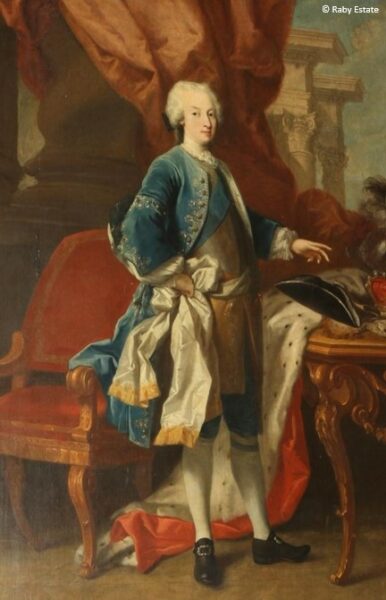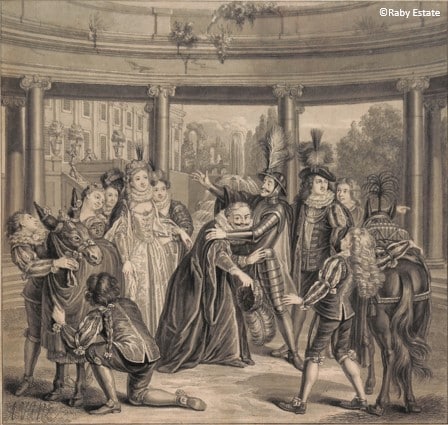Anne Vane (1710-1735) of Raby Castle has been remembered through history as a royal mistress; a woman entangled in a doomed love triangle between Frederick, Prince of Wales, and his once-close friend, Lord John Hervey of Ickworth. Even more scandalous for her time was the fact that she bore two illegitimate children with the Prince.
Like many women in history, her story, as it has been passed down, seems to orbit around the lives of men: she has been largely remembered as the lover of both Frederick and Hervey, and the mother of the Prince’s illegitimate children. On International Women’s Day in an attempt to reclaim her story, Raby Castle’s 2020 intern, Dorothea Fox considers another aspect of her identity—one that she constructed by her own merit. This is her identity as an artist.
Displayed within a bedroom at Raby Castle are seventeen sepia drawings illustrating various scenes from the 17th-century Spanish novel, Don Quixote de la Mancha by Miguel de Cervantes Saavedra. Each of these drawings bears the signature A.VANE, while two of them are dated to 1733 and 1735, corresponding with Anne’s lifetime
In the course of exploring 18th-century illustrations to Don Quixote, it was discovered that Anne’s drawings were copied after the designs of the French artist, Charles Antoine Coypel (1694-1752). And what excellent imitation it was: the 4th Duchess of Cleveland’s Handbook to Raby Castle declares that the artworks were ‘most intelligently and carefully executed’.
These drawings provide a glimpse of a woman beyond the role of royal mistress. Anne obviously devoted a great deal of time and care to them. While history has cast her as little more than a bit-player in the scandals of the court, her Don Quixote illustrations—her artistic legacy—show a different side to her life.
Anne’s Life in the Court of George II
Born in 1710, Anne was the daughter of Gilbert Vane, 2nd Lord Barnard and his wife Mary Randyll whose own marriage had scandalized Gilbert’s parents. Little is known about her childhood and adolescence, but she probably entered the Royal Court in 1725, at the age of fifteen as Maid of Honour to Caroline, the Queen Consort to George II. Over seven years, between 1725 and 1732 Anne was said to have been romantically involved with both Lord Harrington and Lord Hervey, before entering into a relationship with the King and Queen’s son, Frederick, the Prince of Wales.
Her position as his mistress was, at first, probably unofficial and unannounced. However, the Prince’s reputation as a womaniser was no secret to the Court. His relationships with women were referenced by Horace Walpole in his Memoirs of the Reign of King George II:
‘[Prince Frederick’s] chief passion was women, but like the rest of his race, beauty was not a necessary ingredient. Miss [Vane], whom he had debauched without loving, and who had been debauched without loving him so well as either Lord Harrington or Lord Hervey, who both pretended to her first favours, had no other charms than of being a Maid of Honour, who was willing to cease to be so upon the first opportunity.’[1]

Frederick, Prince of Wales (1707-1751) by Jacopo Amigoni ©Raby Estate
When Anne became pregnant she requested leave of absence from her duties, and the Prince had her installed in a house in Soho Square, subsidising her domestic life with £1,600 a year
Anne’s relationship with Frederick was more openly declared upon the birth of their son, who was publicly christened, in June 1732, by the name of Fitz-Frederick Vane. However, the relentless court gossips gave some dispute as to the paternity of Fitz-Frederick. Robert Walpole had been assured by both Lord Harrington and Lord Hervey that they were the true father. Despite those rumours, the Prince was himself convinced that he had conceived the child.
In autumn of that year, Anne moved into a new house in Grosvenor Square, next door to the Bishop of Salisbury. The fascination for her situation gave her near-celebrity status, but also made her an easy target for gossip in newspapers and other publications.
Many of the writings about Anne from this time take the form of satirical prints, plays, stories and poems, which complicates our picture of her. She is cast as a ‘fallen woman’, fashioned as the character of ‘Vanella’: a lesson to unmarried women that bad things would befall them should they deviate from a path of chastity.
After the birth of her son, it seems that Anne’s life began to take a downward turn. In April 1733, she gave birth to a daughter who tragically died within two hours, having first been baptised Amelia. In that same year, Frederick began to drift away from Anne. London gossip reported that he had fathered a child with Anne’s chambermaid before setting his sights on other women.
Not long afterwards, in anticipation of his marriage to Princess Augusta of Saxe-Gotha, the Prince sent letters to Anne persuading her to leave England immediately. He requested that she spent two or three years in Holland or France while he took care of Fitz-Frederick’s education in England. A resentful struggle ensued until it was settled that she would keep her house in Grosvenor Street, with an annual upkeep of £1600 for life, and that she would not be parted from her son.
Not long after this disagreement was resolved, in 1735, that Anne’s health started to decline rapidly. In December, she travelled to Bath to ‘use the waters’ for the recovery of her strength. She died there in March 1736, having received news that her son Fitz-Frederick had died from convulsion fits in Grosvenor Street about a week before.
It was reported that Frederick’s mother and sister thought him ‘more afflicted for the loss of this child than they had ever seen him on any occasion, or thought him capable of being.’[2] The Prince himself died in 1751, at the age of 44, before he could ascend to the throne. After the death of George II in 1760, the crown passed to Frederick’s son with Augusta, George III.
Anne’s Don Quixote Drawings
Anne Vane’s seventeen drawings were excellently copied after Coypel’s designs for Don Quixote. Coypel was one of the most celebrated illustrators of this novel in the 18th century. The designs that he created took on a life of their own as collections of images independent of the novel.
Coypel’s illustrations were celebrated across Europe. It is likely that Anne encountered the images as engravings within an English folio, whichwould have permitted her close and intimate study of them.
The engravings provided illustrative accompaniments to Cervantes’s text, or, in their own albums, permitted a wide audience to view Coypel’s famous designs. And Anne’s drawings, provided a means of self-expression: a demonstration of her artistic talents and, presumably, her fondness for the story of Don Quixote.
Comparing Anne’s drawings with the engravings not only reveals her outstanding skill in copying, but also her skill in translating one form of image into another. By reproducing the prints into the medium of pen and ink, she gave the designs an appearance of light and freshness. In an engraving, the printmaker applies a system of hatching—lines, dots, dashes and other kinds of marking—in order to produce varying tones with the ink. The closer the marks are placed together, the darker those areas will appear.
In the case of the Don Quixote engravings, this process has resulted in quite a dark and heavy rendering of the illustrations, encumbered by areas of dense shadowing and cross-hatching. Anne, however, was not burdened by this process. She was able to work directly onto the white surface of the paper and apply much smoother textures with an ink wash. With her pen, she highlighted all of the delicate and minute details of the figures, foregrounds and backgrounds.

Sancho’s departure for the Island of Barataria. A drawing by Anne Vane copied from an engraving by Charles Antoine Coypel (1694-1752) for Don Quixote de la Mancha by Miguel de Cervantes Saavedra ©Raby Estate
The fact that Anne Vane was a copyist is no reason to depreciate her artworks; it was in keeping with the ideals of upper-class women’s accomplishments in the 18th century and beyond. During this time, women’s education was social and gender-specific. There was a strong and widely-held belief that what they were taught should prepare them for their future lifestyle. A central theme was modesty and obedience, and women’s education thus fostered no great expectations for a life beyond the domestic realm.
Anne was a self-consciously “amateur” artist: someone who could practise the arts for pleasure, thereby distinguishing herself from someone who was motivated by professional or monetary ambition. An abundance of free time is required for the amateur to practise the arts. It therefore follows that artistic pursuits—such as drawing, watercolour painting, music and dancing—were encouraged amongst upper-class women confined to the home. In turn, the talents and social graces demonstrated by the lady amateur were seen to increase her appeal on the matrimonial market.
Ladies’ “accomplishments”, moreover, served to reinforce social differentiation between the aristocracy and the increasingly wealthy middle classes. Knowledge of the arts, and the ability to perform, create and converse appropriately, formed part of a constantly changing system of taste and refinement that was regulated by the upper classes—people who had the time and resources to devote themselves to such activities.
In their artistic tuition, young ladies learned to develop much of their skill by copying the works of others. ‘Originality’, ‘authenticity’ and ‘genius’ were, at this time, the criteria for discerning the artworks of professional male artists. They had greater access to the public realm of art workshops, academies and galleries. Elite women, however, were taught to entertain prospects no higher than seeing their art and handiwork displayed within family rooms. They possessed neither the training nor the expectation to produce ‘original’ works painted in oil, or indeed the gender-laden concept of the ‘masterpiece’.
In these ways, Anne’s status as an amateur and copyist reinforced her socio-economic situation. Her ventures in art—faithfully reproducing Coypel’s illustrations—were compatible with the concept of the ‘ideal woman’ within aristocratic circles. She demonstrated the artistry and flair that young ladies were taught to aspire to. In executing this expansive and clearly time-consuming project, Anne certainly possessed a high degree of ambition and determination.
It is interesting to view the artworks in relation to the events of her life and the decisions that she appeared to make. The fact that her creative endeavours are reflective of the ideals for a woman of her class is not in agreement with the relationships that she pursued out of wedlock. Whether she actively sought out these relationships, or even fully consented to them, however, we cannot know.
What could have motivated her to endure such scandal? Just as she demonstrated in her drawing project, she was evidently, in some sense, ambitious. It is highly likely that she had hoped to raise her position by entering into a liaison with the prince. Even after their relationship was over, she would have still been supported in London with a sizeable house and income. The Prince was also a dedicated patron of the arts and knowledgeable of painting; they may well have bonded over a shared love of art and design.
As for her relationship with Hervey, perhaps there was genuine affection between them. Or perhaps he seemed to provide a sense of security for her, particularly when she was in a vulnerable position after the end of her relationship with the Prince. But, without being able to access Anne’s own words, we can never truly comprehend her emotions, motives and decisions.
What we can learn from her drawings, nevertheless, is that she possessed a lot of talent, creativity and attentiveness. If it was not for her illness and early death, perhaps she might have been able to complete the whole series of twenty-five illustrations. There is this whole other side to Anne—as an accomplished artist—that allows us to see a more rounded picture of her life: a life that was not defined solely by the notoriety that surrounded her.
The story of Anne Vane and these remarkable drawings are explored in the Women of Raby Tour at Raby Castle. These tours, launched for International Women’s Day 2020, will be available once again as soon as Government guidelines permit.
Dorothea Fox carried out an internship at Raby Castle as part of her postgraduate studies in visual culture at Durham University during the summer of 2020.
[1] H. Walpole, Memoirs of the Reign of King George the Second (London: 1847), p. 75.
[2] Hervey, J., Memoirs of the Reign of George the Second, from His Accession to the Death of Queen Caroline, edited by Croker, J.W. (London: 1855), p. 26.
Main blog image shows Hon. Anne Vane, (1710-1735), Circle of Enoch Seeman ©Raby Estate

